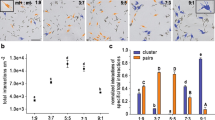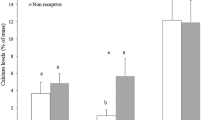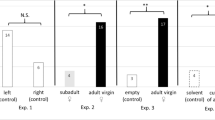Abstract
Behavioral evidence suggests that some male caridean shrimp, such as those of Lysmata species, identify conspecific females via contact pheromones that coat the cuticle surface of the females. In this study, we attempted to determine whether the contact pheromones in three Lysmata species, Lysmata ankeri, Lysmata boggessi, and Lysmata wurdemanni, are glycoproteins as hypothesized previously in a diverse group of aquatic invertebrates. Twenty lectins were screened and lectin-binding experiments indicated that lectin treatment did not affect mate recognition in the shrimps. The behavior of the male-phase (MP) shrimp in the three treatments (non-lectin-treated MP and lectin-treated euhermaphrodite-phase (EP) shrimp, lectin-treated MP and lectin-treated EP shrimp, and lectin-treated MP and non-lectin-treated EP shrimp) and in the control was not different in responding to lectin-treated and control EP shrimp. All the MP shrimp copulated with lectin-treated and control EP shrimp successfully. All the MP shrimp copulated with ethylenediamine tetraacetate-treated EP shrimp (with glycoproteins removed from their cuticle surface) immediately after they detected the EP shrimp. The results suggest that glycoproteins are not likely to be the contact sex pheromones in the three Lysmata shrimp species.
Similar content being viewed by others
References
Ameyaw-Akumfi C, Hazlett BA (1975) Sex recognition in crayfish Procambarus clarkii. Science 190:1225–1226
Andersen SO (1991) Cuticular proteins from the shrimp, Pandalus borealis. Comp Biochem Physiol B 99:453–458
Atema J (1984) Review of sexual selection and chemical communication in the lobster, Homarus americanus. Can J Fish Aquat Sci 43:2283–2290
Bauer RT (1979) Sex attraction and recognition in the caridean shrimp Heptacarpus paludicola Holmes (Decapoda: Hippolytidae). Mar Behav Physiol 6:157–174
Bauer RT (2000) Simultaneous hermaphroditism in caridean shrimps: a unique and puzzling sexual system in the Decapoda. J Crust Biol 20:116–128
Burkenroad MD (1947) Reproductive activities of decapod crustacean. Am Nat 81:392–398
Caskey JL, Bauer RT (2005) Behavioral tests for a possible contact sex pheromone in the caridean shrimp Palaemonetes pugio. J Crust Biol 25:571–576
Dunham PJ (1978) Sex pheromones in Crustacea. Biol Rev 53:555–583
Dunham PJ (1988) Pheromones and behavior in Crustacea. In: Laufer H, Downer GH (eds) Endocrinology of selected invertebrate types. Alan R. Liss, New York, pp 375–392
Etges WJ, Jackson LL (2001) Epicuticular hydrocarbon variation in Drosophila mojavensis cluster species. J Chem Ecol 27:2125–2149
Fletcher N, Hardege JD (2009) The cost of conflict: agonistic encounters influence responses to chemical signals in the shore crab, Carcinus maenas. Anim Behav 77:357–361
Focarelli R, Rosati F (1995) The 220-kDa vitelline coat glycoprotein mediated sperm binding in the polarized egg of Unio elongatulus through O-linked oligosaccharides. Develop Biol 171:606–614
Ginzel MD, Blomquist GJ, Millar JG, Hanks LM (2003) Role of contact pheromones in mate recognition in Xylotrechus colonus. J Chem Ecol 29:533–545
Glabe CG, Clark D (1991) The sequence of the Arbacia punctulata Bindin cDNA and implications for the structural basis of species-specific sperm adhesion and fertilization. Develop Biol 143:282–288
Gleeson RA (1980) Pheromone communication in the reproductive behavior of the crab, Callinectes sapidus. Mar Behav Physiol 7:119–134
Hardege JD, Jennings A, Hayden D, Müller CT, Pascore D, Bentley MG, Clare AS (2002) Novel behavioural assay and partial purification of a female-derived sex pheromone in Carcinus maenas. Mar Ecol Prog Ser 244:179–189
Higgie M, Chenoweth S, Blows MW (2000) Natural selection and the reinforcement of mate recognition. Science 290:519–521
Howard RW, Jackson LL, Banse H, Blows MW (2003) Cuticular hydrocarbons of Drosophila birchii and D. serrata identification and role in mate choice. J Chem Ecol 29:961–976
Kamiguchi Y (1972) Mating behavior in the freshwater prawn, Palaemon paucidens. A study of the sex pheromone and its effect on males. J Facult Sci Hokkaido Univ, Ser VI, Zool 18:347–355
Kelly LS, Snell TW (1998) Role of surface glycoproteins in mate-guarding of the marine harpacticoid Tigriopus japonicus. Mar Biol 130:605–612
Linn CE, Roelofs WL (1995) Pheromone communication in moths and its role in the speciation process. In: Lambert DM, Spencer HG (eds) Speciation and the recognition concept: theory and application. The Johns Hopkins University Press, Baltimore and London, pp 263–300
Lonsdale DJ, Snell TW, Frey MA (1996) Lectin binding to surface glycoproteins on Coullana spp. (Copepoda: Harpacticoida) can inhibit mate guarding. Mar Behav Physiol 27:153–162
Lopez A, Miraglia SJ, Glabe CG (1993) Structure/function analysis of the sea urchin sperm adhesive protein binding. Develop Biol 156:24–33
Marlowe RL, Dillaman RM, Roer RD (1994) Lectin binding by crustacean cuticle: the cuticle of Callinectes sapidus throughout the molt cycle, and the intermolt cuticle of Procambarus clarkii and Ocypode quadrata. J Crust Biol 14:231–246
Miyake A, Beyer J (1974) Blepharmone: a conjugation-inducing glycoprotein in the ciliate Blepharisma. Science 185:621–623
Ryan EP (1966) Pheromone: evidence in a decapod crustacean. Science 151:340–341
Seifert P (1982) Studies on the sex pheromone of the shore crab, Carcinus maenas, with special regard to ecdysone excretion. Ophelia 21:147–158
Shafer TH, Roer RD, Miller CG, Dillaman RM (1994) Postecdysial changes in the protein and glycoprotein composition of the cuticle of the blue crab Callinectes sapidus. J Crust Biol 14:210–219
Shine RR, Reed N, Shetty S, Lemaster M, Mason RT (2002) Reproductive isolating mechanisms between two sympatric sibling species of sea snakes. Evolution 56:1655–1662
Snell TW, Carmona MJ (1994) Surface glycoproteins in copepods: potential signals for mate recognition. Hydrobiologia 292(293):255–264
Snell TW, Stelzer CP (2005) Removal of surface glycoproteins and transfer among Brachionus species. Hydrobiologia 546:267–274
Snell TW, Rico-Martinez R, Kelly LS, Battle TE (1995) Identification of a sex pheromone from a rotifer. Mar Biol 123:347–353
Sugeno W, Hori M, Matsuda K (2006) Identification of the contact sex pheromone of Gastrophysa atrocyanea (Coleoptera: Chrysomelidae). Appl Entomol Zool 41:269–276
Tierney AJ, Thompson CS, Dunham EW (1984) Site of pheromone reception in the crayfish Orconectes propinquus (Decapoda, Cambaridae). J Crust Biol 4:554–559
Ting JH, Kelly LS, Snell TW (2000) Identification of sex, age and species-specific proteins on the surface of the harpacticoid copepod Tigriopus japonicus. Mar Biol 137:31–37
Wabnitz PA, Bowie JH, Tyler MJ, Wallace JC, Smith BP (2000) Differences in the skin peptides of the male and female Australian tree frog Litoria splendida. Eur J Biochem 267:269–275
Wiese L (1965) On sexual agglutination and mating type substances (gamones) in isogamous heterophallic Chlamydamondes. I. Evidence of the identity of the gamone with the surface components responsible for sexual flagellar content. J Phycol 1:46–54
Zhang D, Lin J (2005a) Comparative mating success of smaller male-phase and larger male-role euhermaphrodite-phase shrimp, Lysmata wurdemanni (Caridea: Hippolytidae). Mar Biol 147:1387–1392
Zhang D, Lin J (2005b) Mating without anterior pleopods in shrimp Lysmata wurdemanni, a protandric simultaneous hermaphrodite (Crustacea: Decapoda: Caridea). Crustaceana 77:1203–1212
Zhang D, Lin J (2006) Mate recognition in a simultaneous hermaphroditic shrimp, Lysmata wurdemanni (Caridea: Hippolytidae). Anim Behav 71:1191–1196
Zhang A, Oliver JE, Chauhan K, Zhao B, Xia L, Xu Z (2003) Evidence for contact sex recognition pheromone of the Asian longhorned beetle, Anoplophora glabripennis (Coleoptera: Cerambycidae). Naturwissenschaften 90:410–413
Zhang D, Cai S-L, Liu H, Lin J (2008) Antennal sensilla in the genus Lysmata (Caridea). J Crust Biol 28:433–438
Acknowledgments
This project is partially funded by Project 5010 of Wenzhou Medical College, China. We are grateful for the valuable comments made by the reviewers of the manuscript. The experiments comply with current laws of the United States.
Author information
Authors and Affiliations
Corresponding authors
Additional information
Communicated by M. Byrne.
Rights and permissions
About this article
Cite this article
Zhang, D., Zhu, J., Lin, J. et al. Surface glycoproteins are not the contact pheromones in the Lysmata shrimp. Mar Biol 157, 171–176 (2010). https://doi.org/10.1007/s00227-009-1307-x
Received:
Accepted:
Published:
Issue Date:
DOI: https://doi.org/10.1007/s00227-009-1307-x




